 W
WAfrican Burial Ground National Monument is a monument at Duane Street and African Burial Ground Way in the Civic Center section of Lower Manhattan, New York City. Its main building is the Ted Weiss Federal Building at 290 Broadway. The site contains the remains of more than 419 Africans buried during the late 17th and 18th centuries in a portion of what was the largest colonial-era cemetery for people of African descent, some free, most enslaved. Historians estimate there may have been as many as 10,000–20,000 burials in what was called the "Negroes Burial Ground" in the 1700s. The five to six acre site's excavation and study was called "the most important historic urban archaeological project in the United States." The Burial Ground site is New York's earliest known African-American "cemetery"; studies show an estimated 15,000 African American people were buried here.
 W
WAfrican Cemetery No. 2, also known as The Cemetery of the Union Benevolent Society No. 2, is a historic burial site located in Lexington, Kentucky, United States.
 W
WThe African Jackson Cemetery is a historic cemetery in the western part of the U.S. state of Ohio. Formed by a colony of more than 300 freedmen from Virginia, who were freed in the will of John Randolph of Roanoke, it has been the resting place for many. Active into the 20th century, it is one of the last extant physical remnants of Rossville, a black settlement founded near the city of Piqua in the late 1840s. The cemetery is listed on the National Register of Historic Places because of its connection to the history of free people of color in pre-Civil War Ohio.
 W
WThe African-American Cemetery, known historically as the Colored Cemetery, in the Town of Montgomery, New York, United States, holds the graves of roughly 100, mostly believed to be African slaves who were brought over by the earliest settlers of the region from the Rhenish Palatinate in the mid-18th century. It is located on NY 416 0.1 mile north of the Interstate 84 crossing, near the Wallkill River.
 W
WBehavior Cemetery is a historic cemetery on Sapelo Island outside Hog Hammock, Georgia. The African-American cemetery is believed to date to before the American Civil War although the earliest marker is dated to the late 19th century. The cemetery is located in the center of Sapelo Island, towards the south end, 1‑1/4 miles west of Hog Hammock. It was originally associated with a former community named "Behavior" and slaves of the Thomas Spalding Plantation. An example of African-American burial grounds, the cemetery's grave markers include short posts at either end of the graves with epitaphs on wooden boards nailed to the surrounding trees and personal items included with the deceased. More recent tombstones are cement, granite or metal. It may have been a slave burial ground and is located near the former slave quarters of Thomas Spalding's plantation and the Sugar Mill Complex west of the cemetery. In 1996, it was still in use and was the only cemetery associated with the African American community on Sapelo Island.
 W
WCopp's Hill Burying Ground is a historic cemetery in the North End of Boston, Massachusetts. Established in 1659, it was originally named "North Burying Ground", and was the city's second cemetery.
 W
WEden Cemetery is a historic African-American cemetery located in Collingdale, Pennsylvania. It was established June 20, 1902 making it the oldest existing black owned cemetery in the United States. The cemetery covers about 53 acres and contains approximately 93,000 burials.
 W
WEvergreen Cemetery is a historic African-American cemetery in the East End of Richmond, Virginia, dating from 1891.
 W
WFreedmen's Cemetery was a cemetery in St. Bernard Parish, Louisiana, open from 1867 to 1876. Today, there is a plaque to note where the cemetery once stood. It is considered one of the Historic Cemeteries of New Orleans
 W
WThe Gethsemane Cemetery is located in Little Ferry, Bergen County, New Jersey, United States on an acre on a sandy hill just off U.S. Route 46 and Liberty Street. The cemetery was added to the National Register of Historic Places on April 20, 1994.
 W
WGospel Pilgrim Cemetery was founded in 1882 as a cemetery for African Americans in the 216th general militia district, Athens, Georgia area. Nine acres in size, it contains an estimated 3,500, mostly unmarked, graves.
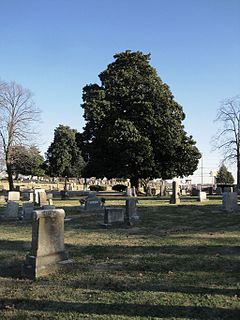 W
WGreenwood Cemetery is situated at 1428 Elm Hill Pike, Nashville in Davidson County, Tennessee, United States. When opened in 1888, it was only the second cemetery in Nashville for African Americans.
 W
WThe Greenwood Cemetery is a historic cemetery in Tallahassee, Florida. It is an African-American or "colored" cemetery located on Old Bainbridge Road, which was originally the main route out of Tallahassee to the northwest. On June 5, 2003, it was added to the U.S. National Register of Historic Places. Professional football player Willie Galimore (1935–1964) is buried there.
 W
WHickory Hill is an estate in Hanover County, Virginia. The 3,300 acre former plantation is located approximately 20 miles (32 km) north of the independent city of Richmond and 5 miles (8.0 km) east of the incorporated town of Ashland. The property was listed in the National Register of Historic Places and the Virginia Landmarks Register in 1974.
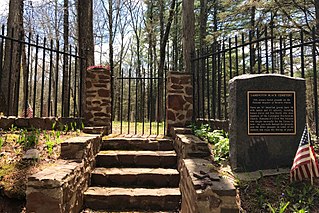 W
WThe Lamington Black Cemetery is an African American cemetery in the Lamington section of Bedminster Township, New Jersey, located on Cowperthwaite Road. It is also known as the Cowperthwaite African American Cemetery. The cemetery is a contributing property of the Lamington Historic District, which was listed on the National Register of Historic Places on June 21, 1984.
 W
WLittle Jerusalem AME Church, also known as Bensalem AME Church, is a historic African Methodist Episcopal church located at 1200 Bridgewater Road in Cornwells Heights, Bensalem Township, Bucks County, Pennsylvania. It was built in 1830, and renovated about 1860 and 1896. It is a 1 1/2-story, one room frame structure with a gable roof. The cemetery surrounding the church contains burials of black Civil War soldiers.
 W
WLumpkin's Jail, also known as "the Devil's half acre", was a holding facility, or slave jail, located in Richmond, Virginia, just three blocks from where the capitol building sits today. It was active from the 1830s through the Civil War. Robert Lumpkin was a notorious and prominent slave trader who bought and sold slaves throughout the South, and turned Lumpkin's Jail into the largest slave-holding facility in Richmond for well over twenty years.
 W
WMount Auburn Cemetery is a historic African American cemetery and national historic district in Baltimore, Maryland, United States. Overlooking the Middle Branch of the Patapsco River to the east, Baltimore's Downtown to the north and railroad tracks to the south, Mt. Auburn Cemetery is surrounded by the Cherry Hill, Westport, Mt. Winans and Lakeland communities.
 W
WMount Hope Cemetery is a historic African-American cemetery and national historic district located at Raleigh, North Carolina. It was established about 1872. The approximate total number of monuments in the cemetery is 1,454, although interment records list over 7,000 individuals. Notable contributing resources include the W. H. Matthews (1828-1902) mausoleum, the front entrance gates and gate posts, and the garden cemetery landscape design.
 W
WMount Moor African-American Cemetery, also known as Mount Moor Cemetery, is a historic African American cemetery located at Palisades Center, West Nyack in Rockland County, New York. It was established in 1849 and contains approximately 90 known graves.
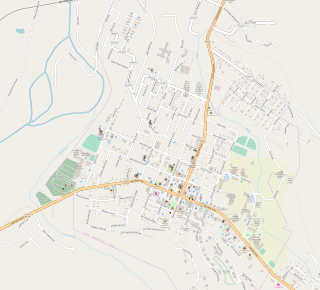 W
WMount Pisgah Benevolence Cemetery is an African-American cemetery in Romney, West Virginia, United States. The cemetery is located along the Northwestern Turnpike below Indian Mound Cemetery overlooking Sulphur Spring Run. Historically known as the Romney Colored Cemetery and more recently as the Romney African-American Cemetery, the cemetery was created for African-Americans in the South Branch Valley who were not permitted to be interred in the city's Indian Mound Cemetery. The cemetery has been in use since the early 19th century and continues to serve Romney's African-American community. It is currently maintained by the Mount Pisgah United Methodist Church, from which it takes its name.
 W
WMount Zion Cemetery/Female Union Band Society Cemetery is a historic cemetery located at 27th Street NW and Mill Road NW in the Georgetown neighborhood of Washington, D.C., in the United States. The cemetery is actually two adjoining burial grounds: the Mount Zion Cemetery and Female Union Band Society Cemetery. Together these cemeteries occupy approximately three and a half acres of land. The property fronts Mill Road NW and overlooks Rock Creek Park to the rear. Mount Zion Cemetery, positioned to the East, is approximately 67,300 square feet in area; the Female Union Band Cemetery, situated to the West, contains approximately 66,500 square feet. Mount Zion Cemetery, founded in 1808 as The Old Methodist Burial Ground, was leased property later sold to Mount Zion United Methodist Church. Although the cemetery buried both white and black people since its inception, it served an almost exclusively African American population after 1849. In 1842, the Female Union Band Society purchased the western lot to establish a secular burying ground for African Americans. Both cemeteries were abandoned by 1950.
 W
WNewtown Cemetery is a historic cemetery in Harrisonburg, Virginia. It is located in the northern part of the city, bounded on the north by Kelley Street and the west by Sterling Street. It is bisected by an extension of Effinger Street, which now serves as part of the cemetery's circulation roads. The roughly 4-acre (1.6 ha) parcel has been the primary burial ground for the city's African-American dead since its founding in 1869. It is estimated to hold 900 graves, including many of emancipated slaves.
 W
WNorth Woodlawn Cemetery, an African-American cemetery located east of Interstate 95 near Sunrise Boulevard in Fort Lauderdale, Florida. It was added to the National Register of Historic Places on 29 November 2017. Founded in the 1920s, lynch victim Reuben Stacey was buried there in 1935. An area that may have been unmarked graves was built over in the construction of Interstate 95 in the 1970s. Another section of unmarked graves of infants may have been paved over in 1995. Burials no longer take place there. Maintained by the City of Fort Lauderdale, it was restored in 2002.
 W
WThe Old City Cemetery is a historic cemetery in Lynchburg, Virginia. It is the oldest municipal (city-owned) cemetery still in use today in the state of Virginia, and one of the oldest such burial grounds in the United States. Since the 1990s it has been operated as a history park and arboretum, in addition to being an active cemetery.
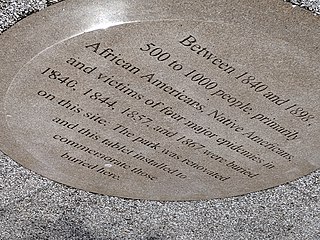 W
WOld Town of Flushing Burial Ground is a historic cemetery located in Flushing, Queens, New York City. It was established in 1840 and known as The Olde Towne of Flushing Burial Ground. It was the result of Cholera and Smallpox epidemics in 1840 and 1844, added by town elders north of Flushing Cemetery due to fears of contamination of church burial grounds. Once known as "Pauper Burial Ground", "Colored Cemetery of Flushing" and "Martins Field", it was purchased by the New York City Department of Parks and Recreation on December 2, 1914 and renamed in 2009 to "The Olde Towne of Flushing Burial Ground". It is co-located with a children's playground called "Martin’s Field". It was placed on the National Register of Historic Places in 2018.
 W
WOlivewood Cemetery, in Houston, Texas, lies near a bend in White Oak Bayou, along the rail line to Chaney Junction, where the First and Sixth wards meet just northwest of downtown. The 6-acre (24,000 m2) cemetery is an historic resting place for many freed slaves and some of Houston's earliest black residents.
 W
WThe Portsmouth African Burying Ground is a memorial park on Chestnut Street in Portsmouth, New Hampshire, United States. The memorial park sits on top of an 18th century gravesite containing almost two hundred freed and enslaved African people. It is the only archeologically verified African burying ground for the time period in New England.
 W
WRest Hill Cemetery is an African-American cemetery in Lebanon, Tennessee.
 W
WThe Rye African-American Cemetery, also known as African Cemetery, is a historic cemetery on North Street in Rye, New York. It is located next to the southwest portion of Greenwood Union Cemetery, and was established as a burying ground for local African-Americans in 1860 through a donation of land by the Underhill family with the intent that it “shall forever hereafter kept, held and used for the purpose of a cemetery or burial place for the colored inhabitants of the said Town of Rye, and its vicinity free and clear of any charge". At least 35 of the individuals buried there are American veterans. The last documented burial in the cemetery was in 1964.
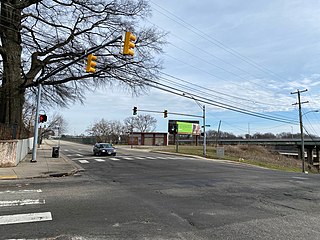 W
WThe Shockoe Hill African Burying Ground was established by the city of Richmond, Virginia, for the interment of free people of color, and the enslaved. This now invisible burying ground is located at 5th and Hospital St. It was created as the replacement for the Burial Ground for Negroes, now also called the African Burial Ground, located in Shockoe Bottom. The Burial Ground for Negroes was closed in 1816 upon the opening of this new African Burying Ground on Shockoe Hill.
 W
WStony Hill Cemetery, also known as the Cemetery of the Asbury Colored Peoples Church, is a historic cemetery located at Harrison, Westchester County, New York. It is an example of a rural, 19th century African American burial ground. The cemetery contains approximately 200 grave sites. It includes seven professionally carved stones, including four government issued markers. Also on the property is the site of a former church demolished before 1930.
 W
WThe Toussaint L'Ouverture County Cemetery is an historical African-American cemetery located in Franklin, Tennessee. It was listed on the National Register of Historic Places in 1995. It is named for Toussaint Louverture, the leader of the Haitian Revolution. The earliest recorded burials date from 1869, but it wasn't officially incorporated until 1884. It is "the oldest African American institution in continuous use" in Williamson County.
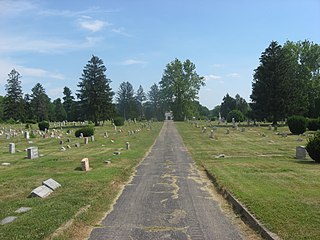 W
WUnion Baptist Cemetery located at 4933 Cleves Warsaw Pike, in the Price Hill neighborhood, is a registered historic district in Cincinnati, Ohio, listed in the National Register of Historic Places on September 20, 2002. It contains 1 contributing buildings. The cemetery is the oldest Baptist African-American cemetery in Cincinnati, founded in 1864 by members of the Union Baptist Church.
 W
WWoodland Cemetery is a historically African American cemetery located in Northeast Richmond, Virginia. It is the second largest African American cemetery in the area, surpassed only by Evergreen Cemetery. The Cemetery was founded by Richmond Planet editor John Mitchell, Jr. who designed the layout of the cemetery himself. The cemetery is designed in the rural cemetery style and incorporates winding roads on terraced slopes. The layout was inspired by the design of Hollywood Cemetery, designed by John Notman in 1847.